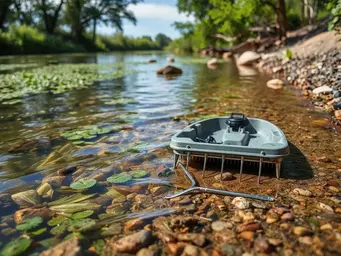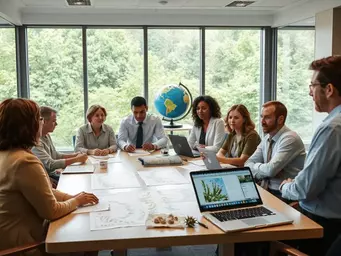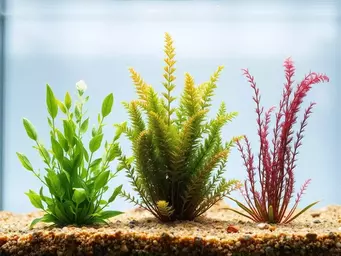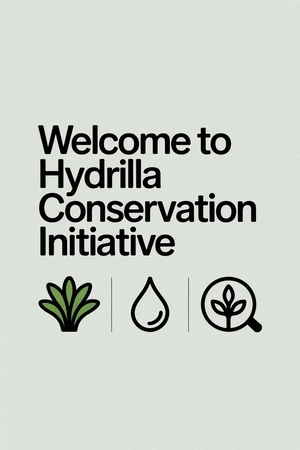How does a single plant manage to disrupt entire ecosystems? The story of hydrilla reveals the astonishing resilience and adaptability of this invasive species. Understanding its biological traits is essential not just for ecological management but for preserving the integrity of our waterways.
What You Will Learn
- Hydrilla utilizes tubers that can remain dormant for years, allowing it to survive unfavorable conditions and rapidly reinvade cleared areas.
- The plant reproduces through fragments, where even small pieces can grow into new plants, complicating control efforts.
- Hydrilla's reproductive strategies necessitate an adaptive management approach that considers environmental factors such as nutrient levels and water temperature.
- Recognizing hydrilla's growth conditions can enhance management efforts, anticipating surges in its population based on nutrient-rich waters and sunlight availability.
Hydrilla's Persistence: Tubers vs. Fragments
This visual highlights the distinct roles of tubers and fragments in Hydrilla's survival and spread, and their impact on control efforts.
Tubers: Dormancy & Re-invasion
Dormancy: Can remain viable for years, surviving unfavorable conditions.
Re-invasion: Sprout into new growth when conditions improve, leading to rapid re-establishment.
Survival Tactic: Long-term Persistence
Fragments: Reproduction & Spread
Reproduction: Each piece can root and grow into a new plant.
Spread: Disturbances (e.g., boat traffic) accelerate rapid colonization across waterways.
Spread Mechanism: Rapid Colonization
Control Challenge: Resistance & Adaptability
Resistance: Mechanical removal and herbicides often fall short due to regeneration.
Adaptability: Thrives in diverse conditions, complicating targeted management efforts.
Management Difficulty: High
Integrated Approach: Key to Success
Combined Methods: Mechanical, chemical, and biological controls for comprehensive management.
Community Engagement: Public awareness and stakeholder collaboration are crucial for long-term solutions.
Strategy: Adaptive & Collaborative
The Biology of Hydrilla: Understanding Tubers and Fragments
To effectively manage hydrilla, it’s crucial to grasp its biological characteristics. This invasive plant has developed unique survival strategies that complicate control efforts. One of its primary methods of persistence is through tubers and fragments, which allow it to regenerate rapidly even after attempts at removal.
As we delve into the biology of hydrilla, I want you to consider the ecological implications. How does this adaptation affect our local waterways? Understanding these mechanisms not only sheds light on the plant itself but also informs our management and conservation approaches.
How Tubers and Fragments Enable Hydrilla’s Persistence
Hydrilla’s ability to thrive hinges on two key reproductive strategies: tubers and fragments. Tubers are specialized storage organs that can remain dormant for extended periods, while fragments result from the plant's physical disturbances.
- Tubers: These can lie dormant until conditions are favorable for growth.
- Fragments: When pieces of the plant break off, each fragment can give rise to a new plant.
- Combination Strategy: Together, they create an incredibly resilient population capable of overwhelming native species.
This dual approach not only aids in hydrilla’s persistence but also complicates our control efforts. Have you ever noticed how quickly aquatic plants can fill a space? That’s the result of this remarkable survival strategy!
The Role of Dormancy and Regeneration in Tubers
Tubers play a vital role in hydrilla’s life cycle. They can remain dormant for years, enabling the plant to survive unfavorable environmental conditions. When conditions become suitable again, these tubers can sprout into new growth, leading to rapid reinvasion of areas previously cleared of hydrilla. For more information on understanding hydrilla's resilience, you can refer to the 2023 Southwest Hydrilla Report.
The dormancy period is not just a survival tactic; it’s a strategic advantage that allows hydrilla to outlast control measures. It’s like having an insurance policy for its existence!
Fragmentation: A Strategy for Reproduction and Spread
Fragmentation is another key to hydrilla’s success. Each fragment, when broken off from the main plant, has the potential to root and grow into a new plant. This means that even small disturbances, like boat traffic or recreational activities, can lead to faster spread. The PA Sea Grant AIS fact sheet on Hydrilla provides further details on its prolific reproduction.
In fact, one small piece can result in a new colony, making it vital that we consider our activities on the water. Have you ever thought about how your interactions can impact the ecosystem? Your choices can play a role in this story!
Biological Characteristics that Complicate Control Efforts
Understanding the biological features of hydrilla is essential for developing effective control strategies. These characteristics can hinder our management efforts significantly.
- Rapid Reproduction: Hydrilla can reproduce both vegetatively through fragments and asexually through tubers.
- Resistance: The plant often shows resistance to mechanical removal and herbicides, complicating eradication efforts.
- Environmental Adaptability: Hydrilla thrives in a variety of environmental conditions, which makes targeted management challenging.
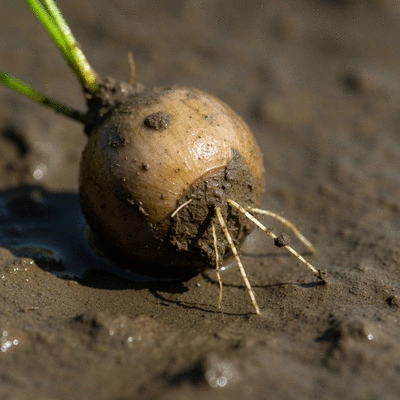
In my experience, the more we understand about hydrilla, the better equipped we are to tackle its challenges. What strategies have you considered or implemented in your efforts against hydrilla?
Resistance to Mechanical Removal and Herbicides
Mechanical removal techniques often fall short because hydrilla can quickly regenerate from fragments left behind. Moreover, herbicides that may initially seem effective can lead to resistance, creating a cycle that is hard to break.
It’s essential to consider that just because a treatment works initially doesn’t mean it will continue to do so. We must stay vigilant and adapt our strategies accordingly.
The Impact of Environmental Factors on Tuber and Fragment Survival
Environmental conditions play a crucial role in tuber and fragment survival. Factors such as water temperature, nutrient levels, and light availability can influence how well hydrilla thrives.
If we want to manage hydrilla effectively, we need to understand these environmental factors. What conditions are conducive to its growth in your area? This knowledge can inform more targeted management strategies.
Understanding Hydrilla's Growth Conditions and Their Influence on Management
Recognizing hydrilla's preferred growth conditions can significantly enhance our management efforts. Hydrilla typically flourishes in nutrient-rich waters with plenty of sunlight. By monitoring these conditions, we can anticipate potential growth surges and prepare accordingly. The first Michigan detection of invasive hydrilla illustrates the importance of early detection and response based on environmental factors.

In my work, I’ve seen firsthand how critical it is to adjust our management techniques based on environmental factors. What adjustments have you made in response to changing conditions in your waterways?
Pro Tip
To effectively manage hydrilla, consider implementing a monitoring program that tracks environmental conditions and hydrilla growth patterns. By regularly assessing nutrient levels and water temperatures, you can anticipate hydrilla's growth surges and adapt your control strategies accordingly. This proactive approach can save time and resources in the long run!
Frequently Asked Questions About Hydrilla
What are tubers and how do they contribute to hydrilla's persistence?
Tubers are specialized storage organs that allow hydrilla to remain dormant for extended periods, surviving unfavorable environmental conditions. They can sprout into new growth when conditions improve, leading to rapid re-establishment in cleared areas.
How do fragments help hydrilla reproduce and spread?
Fragments are small pieces of the hydrilla plant that can break off due to disturbances like boat traffic. Each fragment has the potential to root and grow into a new, independent plant, enabling rapid colonization of new areas.
Why is hydrilla difficult to control with traditional methods?
Hydrilla is difficult to control because it reproduces rapidly through both tubers (asexual reproduction) and fragments (vegetative reproduction). It also shows resistance to mechanical removal and some herbicides, and its adaptability to diverse environmental conditions complicates targeted management.
What is an integrated management approach for hydrilla?
An integrated management approach combines multiple control methods such as mechanical removal (with care to avoid fragmentation), carefully timed herbicide applications, and biological controls (e.g., introducing competing native species). This comprehensive strategy aims to address hydrilla's various survival mechanisms.
How do environmental factors influence hydrilla management?
Environmental factors like water temperature, nutrient levels, and light availability significantly influence hydrilla's growth and survival. Understanding these conditions helps in anticipating growth surges and developing more targeted and effective management strategies.
Summarizing the Role of Tubers and Fragments in Hydrilla Control
As we've explored throughout this article, the relationship between hydrilla, its tubers, and fragments is pivotal in understanding the challenges we face in controlling this invasive species. The resilience of hydrilla, reinforced by its remarkable reproductive strategies, complicates management efforts significantly. By grasping how these mechanisms function, we can better tailor our approaches to combat this persistent invader.
Key takeaways include the following insights into hydrilla's reproductive strategies and the ensuing control challenges:
- Tubers can remain dormant for years, waiting for favorable conditions to sprout.
- Fragments can give rise to new plants, allowing hydrilla to spread rapidly even after attempts at removal.
- The interaction between tubers and fragments necessitates an adaptive management strategy that takes into account various environmental factors.
These insights highlight the importance of recognizing the intricate biology of hydrilla, as it directly informs our management practices and expectations.
The Necessity of an Integrated Management Approach
Addressing the challenges posed by hydrilla requires a cohesive strategy that combines multiple control methods. In my experience as an aquatic biologist, I've found that a successful approach often involves balancing various techniques tailored to specific situations. By integrating mechanical, chemical, and biological methods, we can create a more effective combat plan against hydrilla.
Here are several essential components of an integrated management approach:
- Utilizing mechanical removal to reduce biomass while being mindful of fragmentation risks.
- Applying herbicides carefully timed with hydrilla’s growth phases to maximize efficacy.
- Incorporating biological controls, such as introducing native species that can compete with hydrilla.
The success of these methods hinges not only on their implementation but also on the active engagement of the community and stakeholders. Public awareness can enhance support for these initiatives and foster a collective responsibility for ecosystem management.
Balancing Mechanical, Chemical, and Biological Methods for Success
Finding the right balance between these methods can be challenging but essential. Each has its strengths and weaknesses, so understanding where they fit into the wider strategy is crucial. For instance, while mechanical removal can provide immediate relief from dense hydrilla stands, it may inadvertently result in more fragments if not executed properly. Additionally, the use of herbicides must consider the timing of tuber production to ensure the best results.
The Importance of Public Awareness and Stakeholder Engagement in Management Strategies
To achieve meaningful progress in controlling hydrilla, we need to emphasize the role of community engagement. Raising awareness about hydrilla’s impacts and management strategies is vital. When stakeholders, including local communities, environmental organizations, and policymakers, actively collaborate, we can drive more effective and sustainable solutions.
As part of the Hydrilla Conservation Initiative, I encourage everyone to become advocates for our waterways. Your voice matters, and together we can strengthen our collective efforts in aquatic ecosystem management!
Call to Action: Engaging with Aquatic Ecosystem Management
Encouraging Collaboration Among Stakeholders
Let’s unite our efforts! Collaboration among various stakeholders can significantly enhance our response to hydrilla management. Whether you’re a researcher, educator, or just an environmentally conscious citizen, your participation can make a difference. We can share knowledge, resources, and experiences to develop innovative solutions that promote the health of our waterways.
Staying Updated on Innovative Control Techniques and Research
Staying informed is crucial in the ever-evolving field of aquatic management. Innovations in control techniques are emerging regularly, and it’s essential to keep up with the latest findings. Engaging with platforms like the Hydrilla Conservation Initiative can provide insights into new research and practical management strategies.
Exploring Restoration Techniques for Native Species and Ecosystem Services
Restoration of native species is vital for creating resilient ecosystems that can withstand the challenges posed by invasive species like hydrilla. By exploring and implementing restoration techniques, we can not only combat hydrilla effectively but also enhance the overall health of our aquatic ecosystems. Let's embark on this journey together!
Recap of Key Points
Here is a quick recap of the important points discussed in the article:
- Tubers: These can remain dormant for years, sprouting when conditions are favorable, which complicates control efforts.
- Fragments: Each fragment can grow into a new plant, leading to rapid spread even after removal attempts.
- Integrated Management: Successful management requires a combination of mechanical, chemical, and biological methods tailored to specific situations.
- Environmental Factors: Understanding local conditions such as nutrient levels and water temperature is vital for effective management strategies.
- Community Engagement: Involving local stakeholders fosters a collective responsibility for maintaining healthy aquatic ecosystems.

